Xi'an Great Mosque

Beez Neez now Chy Whella
Big Bear and Pepe Millard
Tue 15 May 2018 22:37
|
The Great Mosque, Xi’an
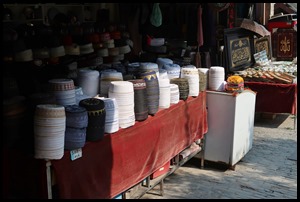   We bimbled through the busy market streets in the Muslim Quarter,
went through a small gate, paid a small entrance fee, were handed a little guide
book, passed a stall selling taqiyah (hats), the
other souvenirs then looked up at an impressive,
old gate. We were in a calm, peaceful and holy place
away from all the outside bustle.
 Next to the gate a map of the Great Mosque area.
Our free little guide reads:
According to the historical records carved in the stone tablets which are
still preserved in it, the mosque was set up in 742 AD during the Tang Dynasty.
So it has already had a history of over 1,300 years. The mosque was restored and
widened in the Song, Yuan, Ming and Qing Dynasties. Especially after the
founding of New China, and owing to the correct policies for the minority
nationalities by the Communist Party and the People’s Government, the
authorities concerned allocates special funds for the renovation of the mosque
every year. So that, the mosque has gradually become such a large and brilliant
complex of the historical architecture. With many beautiful storied buildings,
platforms, pavilions, and halls, it is planed and laid out so well that it looks
very solemn and respectful.
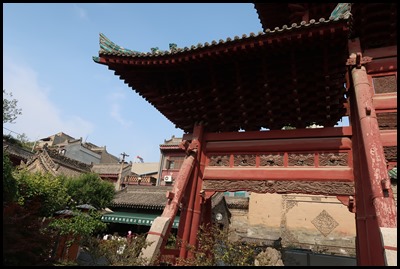  The mosque covers a total area of
more than 13,000 square metres with the buildings covering over 6,000 square
metres. It was built in the shape of a rectangle from the east to the west, and
is divided in to four courtyards.
In the first courtyard, there is
an old wooden archway standing opposite a huge screen
wall decorated with the clay – brick – carvings. It has special upturned eaves,
many layers of brackets, and glazed roof tiles, so that it is very magnificent.
The archway was built at the beginning of the 17th century, dating back over 390
years. On both sides of the archway, there are several side houses, in which
there is some old furniture on display made in the Ming and Qing
Dynasties.
 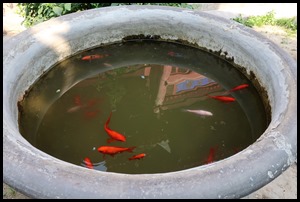 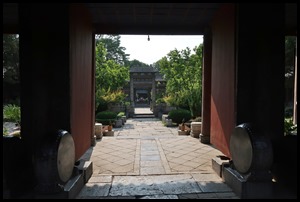 A pretty garden, fish in a tiny ewer and
the Five-Room Hall.
Through the Five-Room Hall, in
the middle of the second courtyard, there stand three connected stone memorial
gateways supported by four pillars. On the top of the main gate, there is a
title inscribed in Chinese calligraphy. It says; “The Court of The Heaven”.
There are stone carved fences around the gateways with the two passages on both
sides. This stone complex was built in the ing Dynasty. Behind it, two stone
tablets are erected there with the decorations of carved dragons. Both of them
are carved with the inscriptions about the repairings of the mosque at the
imperial orders in the Ming and Qing Dynasties. At the backs of them are also
inscribed with some big Chinese characters written respectively by the two
famous calligraphers. These writings are regarded today as some of the best
works of art in China.
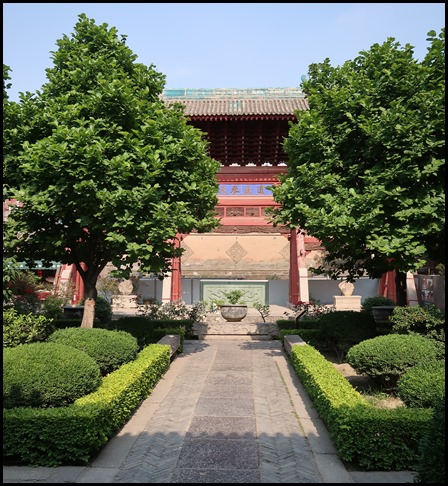 The Imperial
Hall in the third courtyard is the oldest building in the mosque. There
is a piece of stone, called “The Moon Tablet”, in it with an inscription in
Arabic. It was written by a late famous imam, and was about the way of the
calculations of the Moslem Calendar. Now this stone tablet is a very variable
record about the development of Islamism in Shaanxi Province.
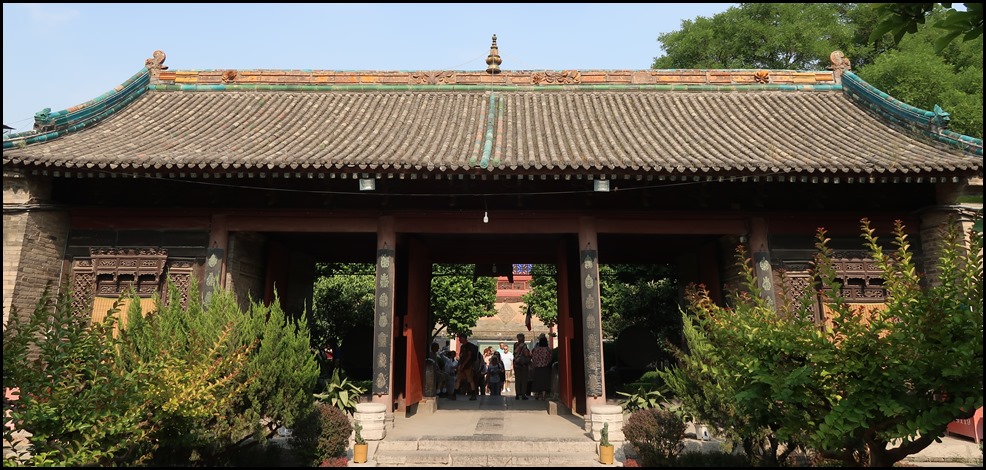 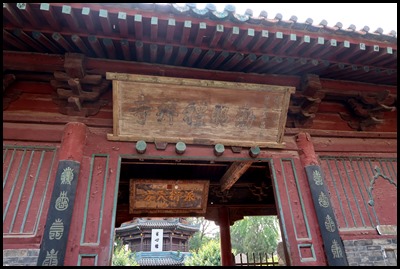 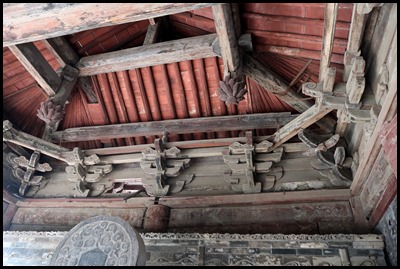 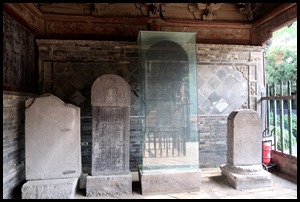 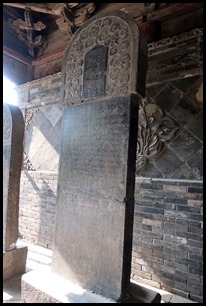 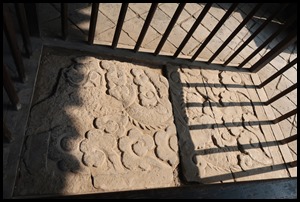 Going from an information board by
Chixiu Hall: a prayer hall in the Southern Song
Dynasty treasures with stones tablets in Chinese, Arabic and Persian
inscriptions and a plaque “Pai Yan Tian Fang” (means that the Islamism in China
originates from Arab countries inscribed by Empress Dowager Cixi
(1835-1908).
It is said that Ma Fuxiang
(1876-1932 AD, courtesy name: Yun Ting, a general of Chinese Muslim, a Hui
person from Hezhou, Gansu Province) today Linxia)) was a bodyguard of Empress
Dowager Cixi when the latter was escaping to the west. He asked Empress Dowager
Cixi to write the inscription of “Pai Yan Tian Fang” for the Grand Mosque when
leaving Xi’an.
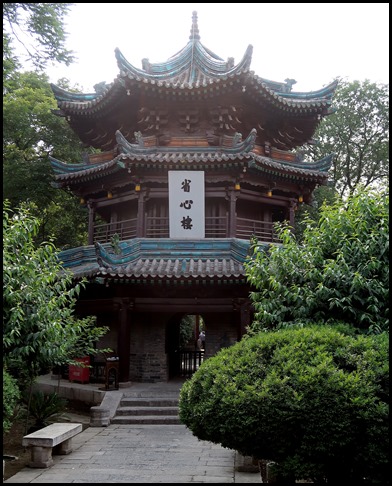 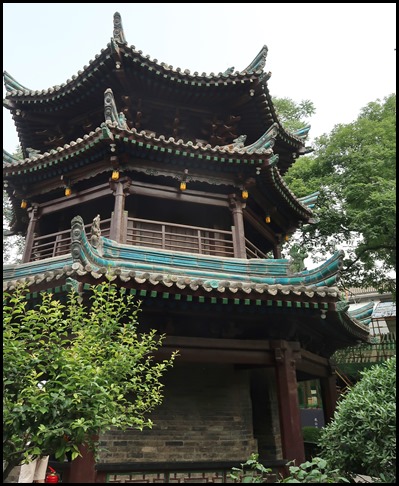   In the middle of the courtyard,
“The Introspection Tower” serves as the minaret,
which is the tallest building in the whole mosque for calling Moslems to pray.
With two storeys, three layers of eaves, and an octagonal roof, it stands high
and solid so that it is very impressive. On the southern side of the minaret is
the Official Reception Hall, while on the northern is the Lecture Hall, in which
the hand-written copy of “The Holy Koran” of the Ming Dynasty and the map of
Mecca City of the Qing Dynasty are well preserved.
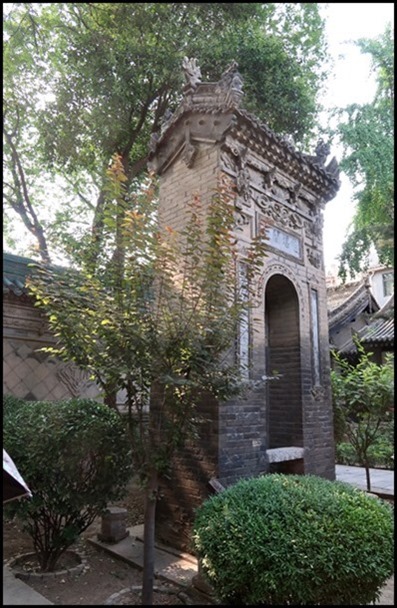  Stele of Merits
and Virtues: Erected in the fourteenth year of Emperor Jiaqing in
Qing Dynasty (1809 AD) the south stele is engraved with a couplet “Mi Tian Cheng
Yi Ji Bei” (in Chinese) inscribed on the bricks of the pavilion housing the
stele, with “Ming Zhen Guan Zhong” on the top scroll.
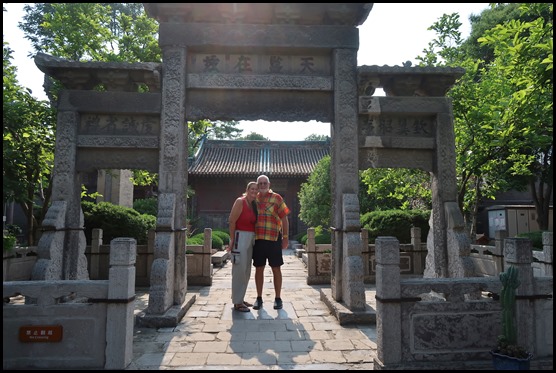 Through the three connected doorways decorated with the fine brick
carvings, that is the last courtyard. What visitors would view first is “The One
God Pavilion”. It is a very special building with a combination of the Chinese
traditional archway and pavilion.
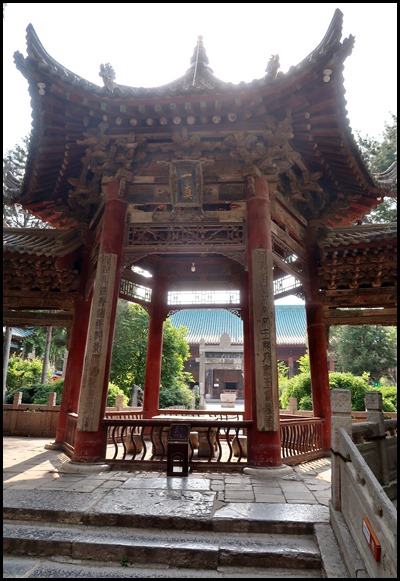 The pavilion as the main body in
the middle is shaped in a hexagon with its eaves upturned and its top protruded.
While, both of its side parts are shaped in triangles and are upturned like
archways. The whole architecture seems to be a beautiful phoenix which is
opening its wings and is about to fly. As it is very lifelike, that is why it is
also named “The Phoenix Pavilion”. Under the eave of
it, a small board with the decorations of carved dragons is hung over there. Its
inscriptions, “One God”, were written by a high ranking official in the Ming
Dynasty. There are some side houses on both sides of the pavilion too. The
southern side ones were built specially for receiving those officials and
generals who came to announce the edicts from the emperors in the successive
dynasties. Today in these houses, there are many historical and cultural relics
of the Ming and Qing Dynasties on display, such as a beautiful fishbone-inlaid
screen made of the 12 species of boxwood, some old tables, chairs, porcelains,
paintings and so on. In the northern houses, there is now preserved an old stone
sundial and several stone tablets with the important inscriptions about the
mosque of the Tang and other Dynasties.
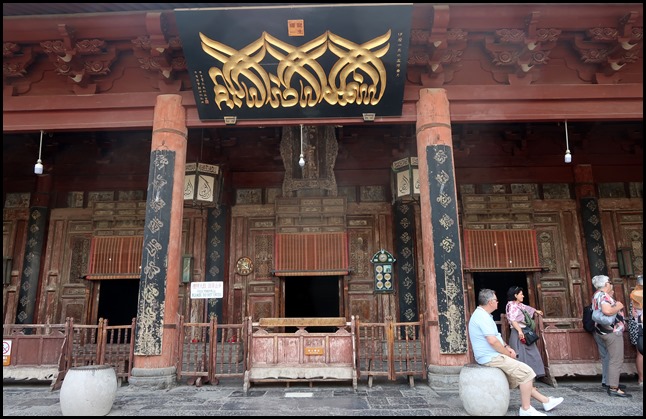 When you walk
further and take the stairways to the big and wide platforms, the lofty and
magnificent hall for worship would appear in
you sight. With the huge eaves and brackets, its roofs are all covered with blue
glazed roof tiles, while its ceilings are eaved with over 600 classical
scriptures, in which all the letters are shaped in the colourful decorative
patterns of grass and flowers.
 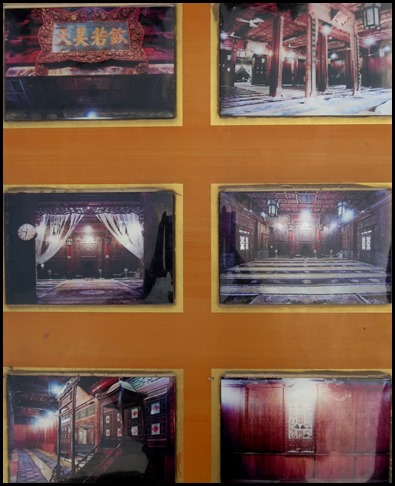 The Prayer Hall is seven rooms wide and nine rooms deep,
the Koran is embedded around the hall which has a concave wall on the west – the
direction of holy Mecca in Saudi Arabia. A small attic called “Khutbah Tower” on
the north side.
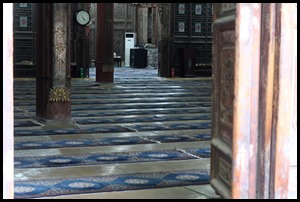 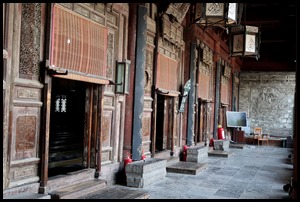  Around the hall inside, all the
pages of “The Holy Koran” are carved in the 600 pieces of huge wooden boards, 30
of them are in Chinese, the others are in Arabic. There are really marvellous
carvings of art, and are rarely seen in the other mosques of the world. The hall
can hold a thousand believers to do their religious services at the same
time.
In 1956, the mosque was decreed
to be an important historical and cultural site under the protection of the
Shaanxi Provincial Government. In 1988, it was further promoted to be one of the
most important sites in China. Since we opened the gates of China to the world
in 1978, this mosque has received over 10,000,000 visitors, and Muslim brothers,
whom came from over 100 countries and areas of the world. It has also received
many heads of states and governments. After you visit, you would surely have the
better understanding of this old mosque and the religious life of the local
Muslims in Xi’an.
   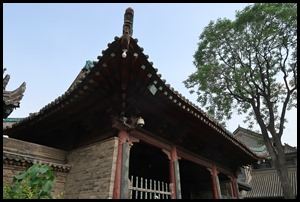 Pictures we
took as we walked down the left-hand side as we bimbled back to the
entrance of the mosque.
A board read: The Five Pillars of
Islam. There are called “Shahada, Salat, Saum, Zakat, Hajj” for
short.
Shahada: It is the primary task
of Muslims. Shahada, is also known as “Testimony of Faith”, refers to the saying
with conviction “There is no god but Allah, and Mohammad is the Messenger of
God”. It is obligatory for all Muslims to recite it at least one time in their
lifetime or beneficent for frequent recitation. It is the profession and
purification of faith for all of those who believe.
Salat: The obligatory prayers are
performed five times (i.e. Dawn, Mid-day, Late-afternoon, Sunset and Nightfall)
a day. All Muslims should face Mecca in Arabia when praying. It also includes
the prayer held every Friday: Eid al-Fitr on Oct 1st and Eid al-Adha on Dec 10th
in the Islamic calendar each year.
Saum (Ramadan): Each year in
September of the Islamic calendar, all Muslims fast from dawn until sundown –
abstaining from food, drink, and sexual relations.
Zakat: For Muslims whose property
amount reaches “Man Guan” 2.5% of the amount shall be paid as the Zakat. “Man
Guan” refers to personal property that has reached a certain amount, excluding
those used for basic needs (such as food, clothing, shelter, transportation and
relevant utensil apparatus). For example, accumulated gold is about 90g and
silver is about 700g, or personal property value is equal to or greater than the
accumulated value of gold or silver. In these cases, 2.5% of property amount
shall be given to the needy whose property hasn’t reached the “Man Guan”
yet.
Hajj: The Hajj (pilgrimage) to
Mecca is required at least once in a lifetime for those who are physically and
financially able to perform it.
These are the so-called Five
Pillars of Islam for the Muslims.
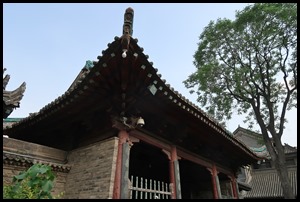  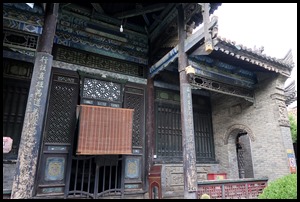 Islam – A Religion of Peace. A
wise man can judge whether or not a religion is peaceful based on its scriptures
and teachings. The Koran is the sacred scripture of Islam. Here are some
presentations and sentences extracted from this book:
1. Worshipping Allah is always
the fundamental principle of Islam. Supreme Allah is the unique that cannot be
questioned. He has 99 names, one of which is Salam (Peace). The Koran says: “He
is Allah, besides whom there is no god; the King, the Holy, the Giver of
peace....” (59:23).
2. Some scriptures about “peace”
and its derivative included in The Koran take up a total of 133 sections. This
shows that peace and harmony ideas play a very important role in Islam’s
scriptures and teachings. Therefore, The Koran says: “O you who believe! Enter
into submission one and all.” (2:208).
3. The Koran also declares that
moving forward to the peaceful and bright road is all Islamists’ most promising
result: “With it Allah guides him who will follow His pleasure into the ways of
safety and brings them out of utter darkness into light by His will and guides
them to the right path.” (5:15-16).
4. Muslims are messengers of
peace, every time they meet each other blessing “May Allah give you peace, love
and good luck”.
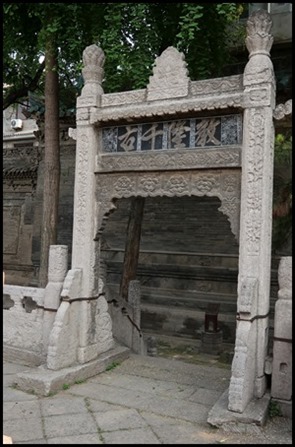   ALL IN ALL LOVELY TO SEE A
TREASURE THE CITY HAS ALWAYS CARED FOR
A REALLY INTERESTING, OLD AND BEAUTIFUL
MOSQUE
|